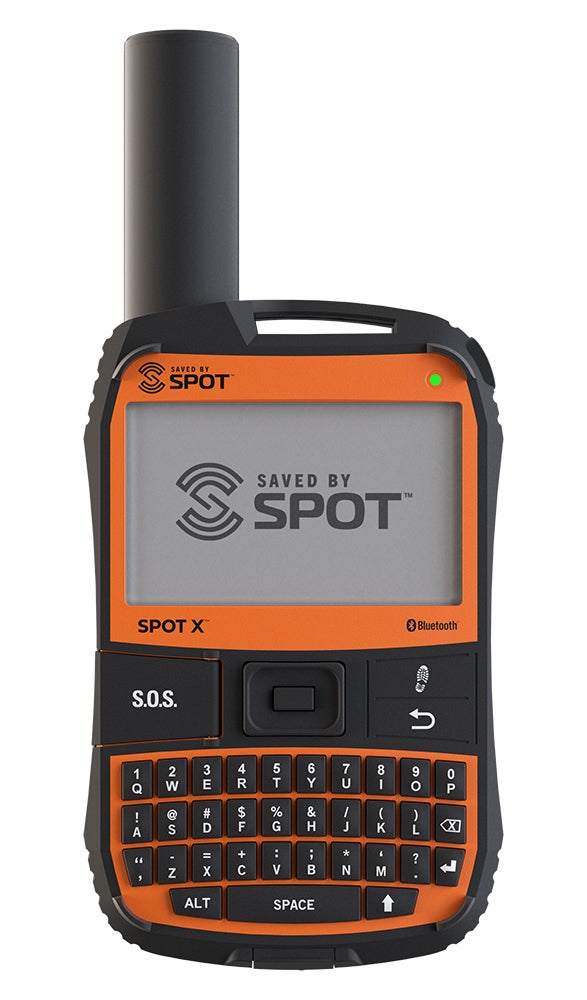This Is Required Gear For Your Emergency Kit

The moment the rope came taut at the bottom of my fall, I knew I had busted my ankle—my crampons had caught and wrenched my foot into an unnatural position . In that split second, I also knew I was going to need a rescue. Will I have phone service? I wondered. Thankfully I did, which made the whole ordeal a bit easier, as I could just call SAR from my smartphone; but even if I hadn’t, I wasn’t worried: I had taken along the Spot X on this backcountry ice-climbing mission.

The Spot X, a phone-sized 2-way messaging satellite and GPS device, was my extra little safety blanket. If the shit hit the fan and I happened to be out of service, I could message family or friends and have them help coordinate a rescue, or I could potentially get in contact with SAR myself.
The more I find myself pursuing adventure climbing in hard-to-reach spots or going off on cold-weather expeditions, the more I’ve come to think that most every climber who isn’t just at the local crag should carry a two-way messaging device. And the Spot X is a further argument in favor of doing so: The price point ($249.99—the most affordable, yet still reliable, satellite messenger I’ve seen on the market), ease of use, and the variety of features all make it a no-brainer.
The Spot X has a physical keyboard in which you can enter text messages, but it also has bluetooth connectivity, meaning you can pair it with your phone via the Spot X app. Once paired with your phone, instead of relying on the small, colorless, text-only screen of the Spot X, you can do all your satellite messaging (whether via text message or email) and other tracking—such as sending regular GPS coordinates of your location, or a preprogrammed check-in message to certain contacts—right on your phone. It makes typing new or selecting preset messages way easier. Unlike a full sat phone, you can’t place voice calls.
A cool application of the bluetooth functionality is that it allows you and your partner to both use the device: If you keep the device on your person, so long as your partner is within 30 feet, they can access it via their phone, too. If Spot increases the range of the bluetooth connectivity in future iterations, it could be extremely useful in some extreme rescue situations, e.g., where the person carrying the satellite device becomes incapacited in an unreachable location.
As with other similar devices, the Spot X can hold a set number of predefined messages, in this case 14. If you’re smart, you’ll pre-program these in before heading out into the field—sending a a message that reads, “Hey, Mom, we’re halfway up the mountain and settled into our bivy for the night!” can take 10 seconds versus spending several minutes to type it out. If you don’t have your phone or your phone battery runs out, you can do all these tasks on the Spot X itself, but here you’ll run into the same kinds of issues that make other two-way devices tricky to use: If you have gloves on, typing with the keyboard is a pain in the ass. I’ve also found myself more than once trying to tap the screen, forgetting that it’s not a touchscreen.
Another standard—but clutch—feature is the SOS button. Simply lift up the little hatch on the device (there to prevent you from pushing the button accidentally), depress the red button, and a request for help, along with your GPS coordinates, will get sent to the GEOS International Emergency Response Coordination Center, where folks will arrange a rescue for you.
At just over 6.5 inches tall and just under 3 inches wide, the Spot X is similar in size to an iPhone (it is, however, about twice as fat). Compared to other satellite devices it’s on the lighter side, but certainly not the lightest.The InReach Mini, from Garmin, is almost half the weight, tipping the scale at just 3.5 ounces, but that device has its own drawbacks, such as the lack of a keyboard (you need to toggle through each letter with a selector tool like you do when typing in something on Netflix with a TV remote).
The battery life of the Spot X was excellent. It lasted well over a week with a single charge, even with prolonged stints in cold weather. It also comes with a non-rated piece of webbing you can use to secure the device to your person or in your pack, though swapping that out for some actual tubular webbing and a rated biner is a worthwhile improvement.
Finally, as with similar devices, you need to buy a data plan. This is where the costs begin to pile up: The plans range from $12–40 per month, depending on how many messages you expect to send, and whether you are subscribing for a full year or a shorter time period. That being said, the Spot X is one of those pieces of gear that you don’t think about until you need it. And if you have it at that moment, you won’t regret the cost for a second.
The post This Is Required Gear For Your Emergency Kit appeared first on Climbing.

